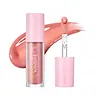What's inside
What's inside
 Key Ingredients
Key Ingredients

 Benefits
Benefits

 Concerns
Concerns

 Ingredients Side-by-side
Ingredients Side-by-side

Hydrogenated Polyisobutene
EmollientDiisostearyl Malate
EmollientCaprylic/Capric Triglyceride
MaskingSilica Dimethyl Silylate
EmollientButyrospermum Parkii Butter
Skin ConditioningSorbitan Isostearate
EmulsifyingSilica
AbrasiveSynthetic Wax
Abrasive1,2-Hexanediol
Skin ConditioningDisteardimonium Hectorite
StabilisingCaprylyl Glycol
EmollientCI 77891
Cosmetic ColorantCalcium Aluminum Borosilicate
Tocopheryl Acetate
AntioxidantCI 77491
Cosmetic ColorantParfum
MaskingCI 77499
Cosmetic ColorantCI 15850
Cosmetic ColorantTin Oxide
AbrasiveSimmondsia Chinensis Seed Oil
EmollientMangifera Indica Seed Oil
EmollientOlea Europaea Fruit Oil
MaskingCI 19140
Cosmetic ColorantCI 15985
Cosmetic ColorantHydrogenated Polyisobutene, Diisostearyl Malate, Caprylic/Capric Triglyceride, Silica Dimethyl Silylate, Butyrospermum Parkii Butter, Sorbitan Isostearate, Silica, Synthetic Wax, 1,2-Hexanediol, Disteardimonium Hectorite, Caprylyl Glycol, CI 77891, Calcium Aluminum Borosilicate, Tocopheryl Acetate, CI 77491, Parfum, CI 77499, CI 15850, Tin Oxide, Simmondsia Chinensis Seed Oil, Mangifera Indica Seed Oil, Olea Europaea Fruit Oil, CI 19140, CI 15985
Hydrogenated Polydecene
EmollientDiisostearyl Malate
EmollientSilica Silylate
EmollientCarthamus Tinctorius Seed Oil
MaskingCaprylic/Capric Triglyceride
MaskingCalcium Aluminum Borosilicate
Ribes Nigrum Seed Oil
EmollientSynthetic Fluorphlogopite
Silica
AbrasiveTocopheryl Acetate
AntioxidantLinoleic Acid
CleansingPhospholipids
Skin ConditioningPhytosterols
Skin ConditioningCaprylyl Glycol
EmollientGlyceryl Caprylate
EmollientAloe Barbadensis Extract
Skin ConditioningTin Oxide
AbrasiveCI 77891
Cosmetic ColorantIron Oxides
CI 45410
Cosmetic ColorantHydrogenated Polydecene, Diisostearyl Malate, Silica Silylate, Carthamus Tinctorius Seed Oil, Caprylic/Capric Triglyceride, Calcium Aluminum Borosilicate, Ribes Nigrum Seed Oil, Synthetic Fluorphlogopite, Silica, Tocopheryl Acetate, Linoleic Acid, Phospholipids, Phytosterols, Caprylyl Glycol, Glyceryl Caprylate, Aloe Barbadensis Extract, Tin Oxide, CI 77891, Iron Oxides, CI 45410
 Reviews
Reviews

Ingredients Explained
These ingredients are found in both products.
Ingredients higher up in an ingredient list are typically present in a larger amount.
Calcium Aluminum Borosilicate is made up of calcium, aluminum, and silicates. It is a glass-like material. In cosmetics, it comes in the form of flakes or microspheres.
Calcium aluminum borosilicate is a bulking agent, meaning it helps thicken a product.
This ingredient is created by slowly mixing several minerals, including kaolin clay.
Although “aluminum” in an ingredient name can raise red flags for some consumers, the form and usage context matter significantly. For typical topical applications, there is no substantial evidence of health risks - such as cancer, neurotoxicity, or systemic “aluminum overload.”
Learn more about Calcium Aluminum BorosilicateThis ingredient is an emollient, solvent, and texture enhancer. It is considered a skin-softener by helping the skin prevent moisture loss.
It helps thicken a product's formula and makes it easier to spread by dissolving clumping compounds.
Caprylic Triglyceride is made by combining glycerin with coconut oil, forming a clear liquid.
While there is an assumption Caprylic Triglyceride can clog pores due to it being derived from coconut oil, there is no research supporting this.
Learn more about Caprylic/Capric TriglycerideCaprylyl Glycol is a humectant and emollient, meaning it attracts and preserves moisture.
It is a common ingredient in many products, especially those designed to hydrate skin. The primary benefits are retaining moisture, skin softening, and promoting a healthy skin barrier.
Though Caprylyl Glycol is an alcohol derived from fatty acids, it is not the kind that can dry out skin.
This ingredient is also used as a preservative to extend the life of products. It has slight antimicrobial properties.
Learn more about Caprylyl GlycolCi 77891 is a white pigment from Titanium dioxide. It is naturally found in minerals such as rutile and ilmenite.
It's main function is to add a white color to cosmetics. It can also be mixed with other colors to create different shades.
Ci 77891 is commonly found in sunscreens due to its ability to block UV rays.
Learn more about CI 77891Diisostearyl Malate is an emollient and most often used in lip products. It comes from isostearyl alcohol, a fatty acid, and malic acid, an AHA.
As an emollient, Diisostearyl Malate helps create a thin film on your skin to trap moisture in. This helps keep your skin soft and smooth.
Silica, also known as silicon dioxide, is a naturally occurring mineral. It is used as a fine, spherical, and porous powder in cosmetics.
Though it has exfoliant properties, the function of silica varies depending on the product.
The unique structure of silica enhances the spreadability and adds smoothness, making it a great texture enhancer.
It is also used as an active carrier, emulsifier, and mattifier due to its ability to absorb excess oil.
In some products, tiny microneedles called spicules are made from silica or hydrolyzed sponge. When you rub them in, they lightly polish away dead skin layers and enhance the penetration of active ingredients.
Learn more about SilicaTin Oxide is an inorganic oxide used to add opacity and volume to a product. In nature, it is already found in mineral form. The main ore of tin is an opaque and shiny mineral called casseterite.
Tin Oxide helps remove translucency in a product, or make it more opaque. Besides adding opacity, tin oxide is used for bulking to add volume.
Tocopheryl Acetate is AKA Vitamin E. It is an antioxidant and protects your skin from free radicals. Free radicals damage the skin by breaking down collagen.
One study found using Tocopheryl Acetate with Vitamin C decreased the number of sunburned cells.
Tocopheryl Acetate is commonly found in both skincare and dietary supplements.
Learn more about Tocopheryl Acetate